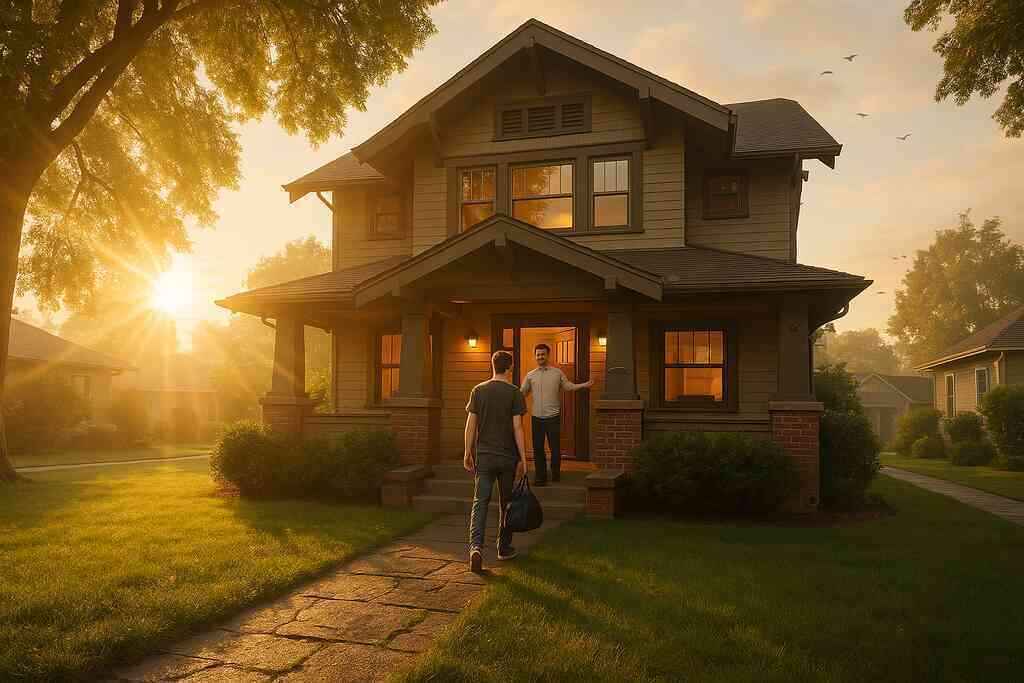
Comparing Sober House Standards Across USA for Long-Term Sobriety
July 1, 2025
Navigating the Complex Landscape of Sober House Standards
Understanding the Importance of the National Sober House Guide
Navigating the diverse and intricate world of sober house standards across the USA requires a robust understanding of the national sober house guide. This guide serves as a crucial resource for individuals seeking long-term sobriety. It establishes a framework that offers consistency, helping to streamline processes and set expectations across different regions. Emphasizing best practices, the guide ensures that all sober living houses provide safe, supportive environments for residents. Moreover, having such a guide enhances communication and clarity among stakeholders, from residents to regulatory bodies. Ultimately, it is an invaluable tool for those on the recovery journey, ensuring a structured and uniform approach to living sober.
State-by-State Sober Living Regulations Unveiled
The sober living regulations in California, for example, differ significantly from those in other states, highlighting the importance of understanding local laws. State-by-state variations in regulations address the unique demographics and needs of each region, offering tailored solutions to the challenges of addiction recovery. This individualized approach helps cater to the specific requirements of local populations, facilitating better outcomes in the recovery process. As regulations evolve, it is paramount that residents and managers of sober homes stay informed about changes that may affect compliance and best practices. By embracing these unique regulations, facilities across the nation can enhance their service to those striving for long-term sobriety. Understanding these regulations not only aids in legal compliance but also contributes significantly to the effectiveness and success of addiction recovery.
Optimizing the Search for a Top Sober House Near You
The search for a top sober house near you can seem daunting, but utilizing effective strategies simplifies the process. One effective tool is the use of comprehensive directories like Top Sober House, which provides vital information about local sober living facilities. This resource enhances the search experience by offering detailed profiles and reviews, helping you identify the optimal sober environment for your needs. Additionally, focusing on house rules and ensuring they align with personal recovery goals is essential in choosing the right facility. Moreover, engaging with residents and seeking their testimonials can provide real-world insights into daily routines and the actual support offered by the facility. Ultimately, optimizing your search involves leveraging available resources and aligning them with personal goals for a successful recovery journey. By incorporating supportive community networks, such as those available in sober living near Connecticut, individuals can find a structured support system essential for maintaining sobriety.
The Intricacies of Sober Residence Certification
Defining Quality Sober Homes: What Sets Them Apart
Quality sober homes serve as a cornerstone for achieving long-term sobriety. These homes provide a structured and supportive environment, going beyond basic shelter to foster genuine recovery. Essential components of a quality sober home include a stable living space, enforced house rules, and a community committed to sobriety. They emphasize peer support and integrate components of a safe sober environment, ensuring residents feel secure in their journey. Additionally, these homes often incorporate 12-step programs and encourage participation in alcoholics anonymous meetings, establishing routine and accountability. The ambiance, structured routines, and support systems within these homes distinguish them from ordinary living conditions, offering a haven for individuals dedicated to recovery.
Certification Processes Across the USA: A Comparative Analysis
Certification processes for sober residences vary widely across the United States. Each state implements its own standards, reflecting differing levels of regulation and oversight. This variance can be seen from sober house standards in Alabama to the rigorous requirements of Ohio sober residence certification. Certification typically involves meeting safety codes, demonstrating effective management, and proving a commitment to resident welfare. Facilities undergo regular inspections to ensure they adhere to these standards, maintaining a high level of care for residents. Stringent certification not only helps in maintaining quality but also instills trust in residents and their families, ultimately enhancing recovery outcomes. By comparing certification processes, stakeholders can learn best practices and push towards universal standards of excellence in recovery housing.
Ensuring Compliance: The Role of Regulatory Bodies in Sobriety Success
Regulatory bodies play a pivotal role in ensuring the success of sobriety by enforcing compliance in sober living environments. These organizations establish guidelines that safeguard the health and safety of residents, setting the stage for effective recovery. Compliance with regulations ensures that sober homes are not just a transitional shelter but a transformative setting for sustainable sobriety. In states like Texas, significant focus is placed on sober living success by ensuring that all facilities meet established criteria. Regulatory oversight prevents fraudulent practices, protecting residents from unsatisfactory living conditions and promoting an environment conducive to recovery. The collaborative efforts between sober homes and regulatory bodies enhance the overall quality of sobriety support available, making these homes a critical component of the addiction recovery landscape.

Creating Effective and Supportive Recovery Environments
Components of a Safe and Optimal Sober Environment
A safe and optimal sober environment is critical in fostering long-term sobriety. The cornerstone of such an environment includes secure housing combined with a nurturing and supportive framework. Residents should feel physically and emotionally safe, with access to amenities that cater to their recovery needs. The atmosphere of sober living houses should encourage community bonding, accountability, and personal growth. Consistent guidelines and supportive community networks form an effective backdrop for a meaningful recovery journey. Moreover, incorporating professional services, such as addiction recovery services, ensures that residents receive comprehensive support aligned with their healing processes.
Establishing House Rules and Daily Routines in Sober Living
House rules and daily routines are pivotal in structuring a productive and conducive sober living environment. These rules promote discipline and consistency, essential for residents transitioning from addiction to recovery. Effective house rules address hygiene, behavior, visitation policies, and participation in house activities, ensuring a harmonious living space. Similarly, structured routines, emphasizing regular meal times and curfews, instill a sense of normalcy and predictability. Daily schedules that include chores, job searches, or continued education also aid in rebuilding self-esteem and work ethic. Importantly, incorporating elements like mental health centers into routines further supports holistic recovery, bridging the gap between sobriety and mental wellness.
Peer Support and 12-Step Programs: Cornerstones of Recovery Housing
Peer support and 12-step programs are foundational components of successful recovery housing. These elements foster a collaborative environment where residents can share experiences and support one another. Engaging in peer-driven support systems introduces empathy and understanding, crucial elements in sustaining sobriety. The integration of 12-step programs offers structured guidance, helping individuals take responsibility and make amends, crucial steps in recovery journeys. These programs not only complement medical treatment but also enhance communal ties, presenting a united front against addiction challenges. For those navigating the rocky path of early recovery, peer support for sobriety offers a lifeline, sustaining progress through shared commitment and encouragement.
Assessing Structured Recovery Programs for Long-Term Sobriety
Evaluating Sober Living Benchmarks and Sobriety Success Factors
Structured recovery programs are indispensable in achieving long-term sobriety, providing a blueprint for success. Evaluating sober living benchmarks involves examining various elements such as house rules, peer support systems, and the incorporation of treatment programs. Each benchmark acts as a stepping stone, ensuring that residents progress steadily in their recovery journey. The combination of these factors contributes significantly to sobriety success. Moreover, measuring progress against established benchmarks allows residents to track their journey, offering motivation and clarity on their path to recovery. Effective programs often integrate these benchmarks seamlessly, enhancing the supportive environment necessary for sustained sobriety. For a deeper understanding of specific strategies, you can explore sober living strategies.
Inpatient vs. Outpatient Programs: Finding Your Path
The choice between inpatient and outpatient programs is pivotal in structuring a successful recovery. Inpatient programs offer immersive environments, removing individuals from potential triggers and providing round-the-clock care. This level of support is particularly beneficial in the early stages of recovery, offering a sanctuary for intensive healing. On the other hand, outpatient programs allow for greater flexibility, enabling individuals to maintain personal responsibilities while receiving counseling and therapy. Both options include unique benefits tailored to different recovery stages. Personal circumstances and individual goals heavily dictate the choice of program, making it crucial to assess personal needs when deciding on a path. Understanding the dichotomy between these two approaches is essential in navigating one’s recovery journey.
Role of Rehab Centers and Support Groups in Recovery Journeys
Rehabilitation centers and support groups serve as bedrocks in the recovery process, providing essential guidance and community support. Rehab centers offer structured yet compassionate environments where individuals can focus on healing and overcome addiction challenges. These facilities are often equipped with professional staff who provide medical support and counseling. Additionally, support groups like Alcoholics Anonymous play a crucial role in creating peer-driven networks, encouraging shared experiences and mutual encouragement. The collective power of these community-based approaches fosters a sense of belonging and accountability, which is vital in maintaining sobriety. Integrating such resources into one’s recovery path enhances the overall journey, empowering individuals to navigate their sobriety with confidence. This holistic approach underlines the need for comprehensive support systems, as detailed in various alcohol rehabilitation programs.
Embracing the Future of Regulated Sober Living in America
Predicting Trends in USA Recovery Housing
The future of recovery housing in the USA is poised for transformation, driven by evolving standards and innovative practices. As more states recognize the importance of standardized regulations, we anticipate an increased focus on uniformity across sober living facilities. This trend not only ensures safety and efficacy but also strengthens the legal framework governing sober residence certification. Moreover, the incorporation of technology in monitoring and managing sober living environments will likely become prevalent, streamlining operations and enhancing accountability. As these trends take hold, residents can expect improved facilities and comprehensive support systems that respond adeptly to individual recovery needs. Staying informed about evolving USA sober house regulations is crucial for both stakeholders and residents, aligning expectations with the progressive landscape of recovery housing.
Innovations in Supporting Residents of Sober Living Homes
Innovations in supporting residents of sober living homes continue to reshape how recovery environments operate. Enhanced methods of communication, including digital platforms, allow residents to engage seamlessly with their support networks. These innovations facilitate increased engagement in sobriety support in Washington, strengthening community bonds and accountability. Additionally, the integration of holistic therapies offers residents alternative healing methods, such as mindfulness practices and art therapy, which complement traditional recovery approaches. These advancements foster a well-rounded support system catering to diverse recovery journeys. By utilizing state-of-the-art resources, sober homes can create environments that not only support sobriety but also enhance personal growth and emotional well-being.
The Path Forward: Enhancing Residential Sobriety Standards for All
Enhancing residential sobriety standards across the nation requires a collective effort from regulatory bodies, recovery communities, and sober house operators. The focus must be on establishing universal criteria that ensure quality while respecting local adaptation to cater to demographic needs. Encouraging research and data collection on what constitutes effective recovery housing will guide policy formulation, leading to tailored solutions that address specific challenges faced by sober communities. Residents should benefit from robust support structures that incorporate advances in medical and psychological care, reinforcing their recovery and personal development. By advancing standards, the path forward becomes clearer, promising an inclusive approach to sobriety that aligns with the disease theory of alcoholism in addressing the underlying causes and complexities of addiction.

Finding Your Supportive Haven for Sobriety
Identifying the Best Sober Living Program for Your Needs
Finding the right sober living program tailored to your needs is paramount for achieving long-term sobriety. Start by assessing the standards of each facility through comprehensive directories, such as Top Sober House, which offer invaluable insight into the various programs available across the USA. Consider the house rules, the environment, and the specific resources each program provides. Evaluate how well these align with your personal recovery goals and requirements. Visiting potential sober homes and speaking with current residents can also greatly influence your decision-making process, offering a glimpse into daily life and interactions. This dedication to selecting the right program not only enhances your recovery journey but also provides a robust foundation for sustained sobriety. Choose wisely, as the right supportive haven will act as a beacon, guiding you through your recovery journey.
Cultivating a Supportive Community in Sober House Environments
Cultivating a supportive community within sober house environments is essential for fostering lasting sobriety. This supportive bond is cultivated when residents engage in shared activities and peer-driven initiatives. The integration of structured recovery programs in New York, for example, highlights how communal support and individual progress intertwine to bolster recovery. These collaborative experiences build trust and accountability, both crucial for creating a safe and nurturing environment. It is this community strength that helps residents navigate challenges, encouraging them to stay committed to their sobriety goals. Furthermore, incorporating group discussions and community-building exercises ensures everyone feels heard and valued. Ultimately, such a supportive environment not only enhances individual recovery journeys but also reinforces the overall stability and positivity of the sober community.
By focusing on these aspects, you pave the way for a resilient recovery path, surrounded by shared understanding and mutual support. Explore additional resources and learn about the recovery journey support available to maximize the benefits of your chosen sober living environment.
Frequently Asked Questions
Question: What role does the national sober house guide play in achieving long-term sobriety in USA sober houses?
Answer: The national sober house guide is a vital resource for individuals pursuing long-term sobriety as it lays out sober living best practices across the USA. It provides a structured framework that ensures consistency in the standards of sober houses, making it easier for residents and managers to establish safe and supportive environments. By following the national guide, sober houses can offer regulated sober living conditions that are conducive to addiction recovery, thereby fulfilling the sobriety success factors needed for effective sober environments. This framework promotes structured recovery programs, which are essential for sustaining long-term sobriety.
Question: How do state variations in sober living regulations affect choices for those seeking recovery housing, as discussed in the blog ‘Comparing Sober House Standards Across USA for Long-Term Sobriety’?
Answer: State variations in sober living regulations present unique challenges and opportunities for individuals seeking recovery housing. These regulations accommodate different demographics and regional needs, offering tailored sober environments that can enhance recovery outcomes. For instance, regulations in California might differ significantly from those in Ohio, affecting how sober living homes operate and maintain compliance. By understanding these differences, as highlighted in the blog ‘Comparing Sober House Standards Across USA for Long-Term Sobriety,’ individuals can make informed choices that align with their recovery journey. This personalized approach, supported by Top Sober House’s state-specific directories, ensures choosing a sober house that meets one’s sobriety standards, promoting a supportive recovery environment.
Question: What are the certification processes across different states for ensuring quality sober homes, and how does Top Sober House assist in navigating this process?
Answer: Certification processes for sober residences vary widely across states, impacting how these homes are managed and maintained. Quality sober homes must meet stringent criteria, including safety codes, effective management, and a commitment to resident welfare. Top Sober House assists individuals by offering comprehensive information on state-specific certification requirements, helping residents and house managers stay informed about compliance and regulatory standards. With Top Sober House’s resources, individuals can confidently navigate the complexities of sober residence certification, ensuring they choose a home that adheres to superior residential sobriety standards and promotes sustainable recovery.
Question: How can one efficiently search for an optimal sober living program suitable for their recovery needs?
Answer: Searching for an optimal sober living program can be simplified by utilizing the resources offered by Top Sober House. Their extensive directory allows users to explore various sober living houses near them, providing detailed information about house rules, environment, and resources available. By focusing on personal recovery goals and aligning them with the services offered, individuals can efficiently identify the most suitable recovery housing. Moreover, visiting potential sober homes and engaging with current residents provides invaluable insights into daily life and community support. By selecting a program that resonates with their needs, individuals can ensure a supportive recovery journey that fosters long-term sobriety.
Question: What is the significance of peer support and 12-step programs in sober housing, and how does Top Sober House promote these elements?
Answer: Peer support and 12-step programs are cornerstones of successful recovery housing as they foster communal ties and individual accountability. Engaging in these structured programs enables residents to share experiences and provide mutual encouragement, which is critical in sustaining sobriety. Top Sober House emphasizes these components by ensuring that listed sober homes integrate these programs into their routine amenities. These elements not only enhance sobriety success but also provide a supportive network where individuals feel understood and motivated. By promoting peer support and 12-step initiatives, Top Sober House helps create optimal recovery environments that contribute significantly to the residents’ paths to long-term sobriety.


